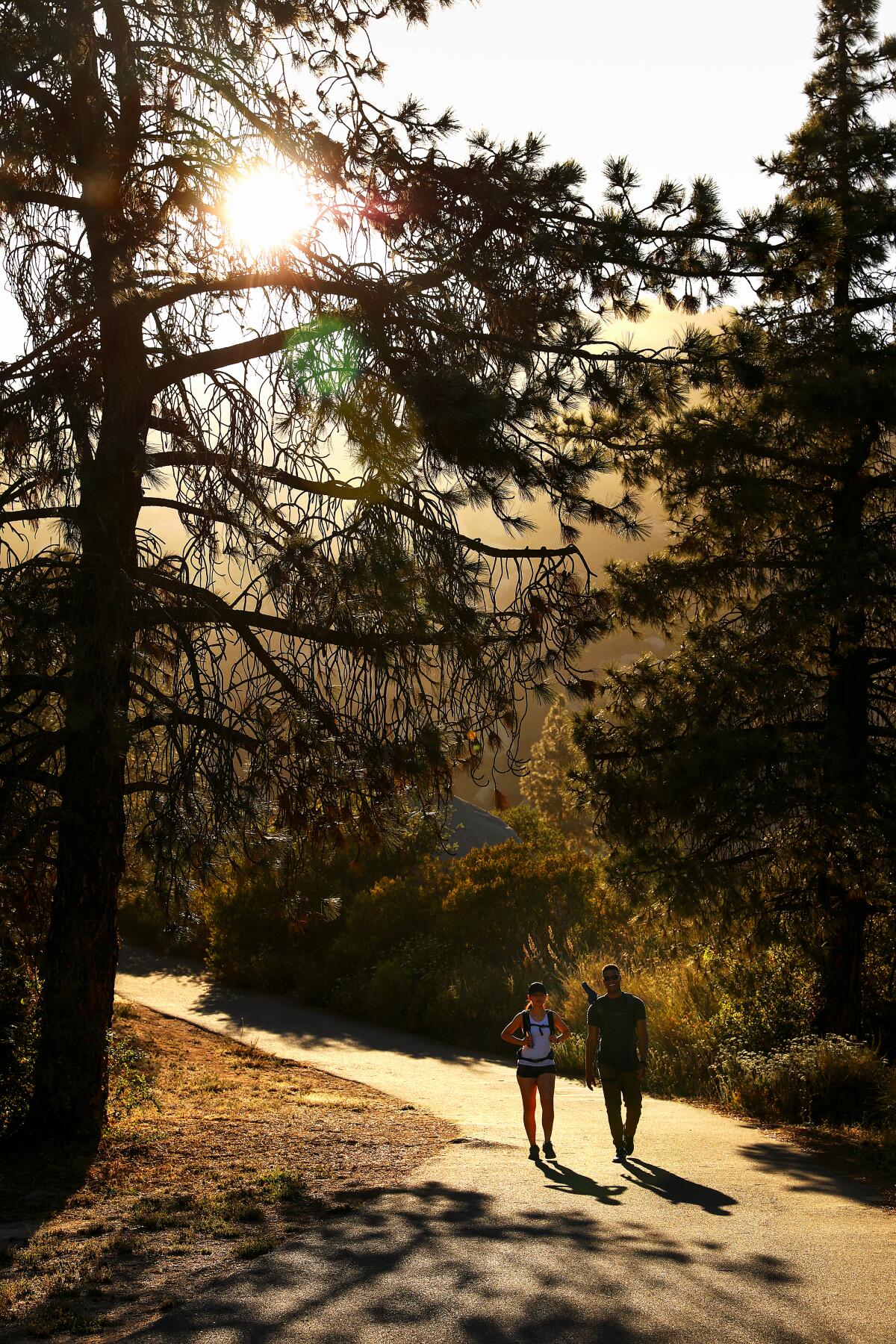
Hikers head down the trail that leads to Potato Chip Rock.
(Christina House / Los Angeles Times)
19 exceptional San Diego hikes
- Share via
The rugged desert wilderness. Dense coniferous forests. Luscious rolling grasslands. Intertidal wetlands. Sandstone canyons.
For outdoor enthusiasts, San Diego County boasts so much more than just its stunning shoreline. These 19 treks, geographically dispersed and all doable in half a day, are a small but mighty sampling of the diverse hiking highlights across “America’s finest city.”
Planning your weekend?
Stay up to date on the best things to do, see and eat in L.A.
Showing Places
Torrey Pines State Natural Reserve
San Diego Coastal Trail
2.3-mile loop
Easy
350 feet

(Christopher Reynolds / Los Angeles Times)
In “America’s finest city,” where can you find America’s finest sandy stretch? Head to Torrey Pines State Natural Reserve, a 2,000-acre gem nestled between Del Mar and La Jolla that boasts dramatic sandstone cliffs, panoramic ocean views and, of course, majestic specimens of its namesake arbor, the Torrey pine.
Though the reserve (and its less-visited, but equally beautiful extension) warrants a full day to explore its many paths, a good highlight hike is the 2.3-mile beach trail loop that starts at the western parking lot of the reserve’s bluff-top visitor center. Before you begin, grab a trail map, check out the small nature and history museum and gawk at the stunning views to the north and east over the vast Los Peñasquitos marsh and lagoon. With constant vistas of the Pacific, you descend past a large, rocky outcropping (Red Butte) and through chaparral classics such as laurel sumac, toyon, sagebrush and manzanita. Still, the tree-de-force is the Torrey pine. Apart from Santa Rosa of the Channel Islands, this is the only natural spot on Earth where you’ll find these trees, and they are truly a sight to behold.
As you meander along the beach trail, take note of a few branching paths — Razor Point and Yucca Point trails lead you to some amazing overlooks of sandstone canyons if you’re up for some additional mileage. Otherwise, head down the beach trail’s 100-plus steps to reach the sand. Here, continue north, looking for ospreys and even nesting peregrine falcons in the cliffs above. At the beach parking lot, ascend the paved road, passing additional hiking trails (Guy Fleming and Parry Grove trails are both worth a visit) on the way back to the visitor center.
Park in the paved lot (there’s demand-based pricing: $12 to $25); no dogs allowed. Start at the beach trail from the visitor center’s western parking lot. The beach trail is accessible during low tide.
Though the reserve (and its less-visited, but equally beautiful extension) warrants a full day to explore its many paths, a good highlight hike is the 2.3-mile beach trail loop that starts at the western parking lot of the reserve’s bluff-top visitor center. Before you begin, grab a trail map, check out the small nature and history museum and gawk at the stunning views to the north and east over the vast Los Peñasquitos marsh and lagoon. With constant vistas of the Pacific, you descend past a large, rocky outcropping (Red Butte) and through chaparral classics such as laurel sumac, toyon, sagebrush and manzanita. Still, the tree-de-force is the Torrey pine. Apart from Santa Rosa of the Channel Islands, this is the only natural spot on Earth where you’ll find these trees, and they are truly a sight to behold.
As you meander along the beach trail, take note of a few branching paths — Razor Point and Yucca Point trails lead you to some amazing overlooks of sandstone canyons if you’re up for some additional mileage. Otherwise, head down the beach trail’s 100-plus steps to reach the sand. Here, continue north, looking for ospreys and even nesting peregrine falcons in the cliffs above. At the beach parking lot, ascend the paved road, passing additional hiking trails (Guy Fleming and Parry Grove trails are both worth a visit) on the way back to the visitor center.
Park in the paved lot (there’s demand-based pricing: $12 to $25); no dogs allowed. Start at the beach trail from the visitor center’s western parking lot. The beach trail is accessible during low tide.
Show more Show less
Route Details
Annie’s Canyon
San Diego County Canyon Trail
1.7-mile out-and-back
Easy
200 feet
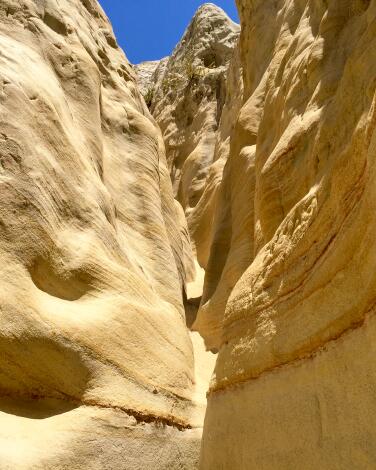
(Matt Pawlik)
Annie’s Canyon Trail in the 979-acre San Elijo Lagoon Ecological Preserve features one of the most unique quarter-mile stretches in SoCal: a narrow pathway through a slot canyon, right next door to an expansive coastal wetland.
Start at the Gemma Parks Interpretive Trail off Rios Avenue heading east, and take a left at the first junction for a slightly longer alternate route that hugs the lagoon and features interpretive signage about the surrounding native flora, such as laurel sumac, sage and arroyo willows. At the Annie’s Canyon trail sign, head right to complete the one-way quarter-mile loop through the eroding sandstone walls. Venturing through this otherworldly canyon, the smooth, water-sculpted corridors cocoon you as you navigate tight corners and ascend natural stone stairs. Along the way, you’ll pass hidden caves — hide-and-seek, anyone? A ladder ultimately leads you out of the slot canyon, revealing a stunning vista of the lagoon and the Pacific. If you want more mileage, you can head east under the freeway or north along the railroad tracks to explore more of the marsh preserve.
Park on the street (come early to avoid crowds); dogs allowed, but not in the slot canyon.
Start at the Gemma Parks Interpretive Trail off Rios Avenue heading east, and take a left at the first junction for a slightly longer alternate route that hugs the lagoon and features interpretive signage about the surrounding native flora, such as laurel sumac, sage and arroyo willows. At the Annie’s Canyon trail sign, head right to complete the one-way quarter-mile loop through the eroding sandstone walls. Venturing through this otherworldly canyon, the smooth, water-sculpted corridors cocoon you as you navigate tight corners and ascend natural stone stairs. Along the way, you’ll pass hidden caves — hide-and-seek, anyone? A ladder ultimately leads you out of the slot canyon, revealing a stunning vista of the lagoon and the Pacific. If you want more mileage, you can head east under the freeway or north along the railroad tracks to explore more of the marsh preserve.
Park on the street (come early to avoid crowds); dogs allowed, but not in the slot canyon.
Show more Show less
Route Details
Garnet Peak
San Diego County Mountain Trail
4.2-mile out-and-back
Moderate
700 feet
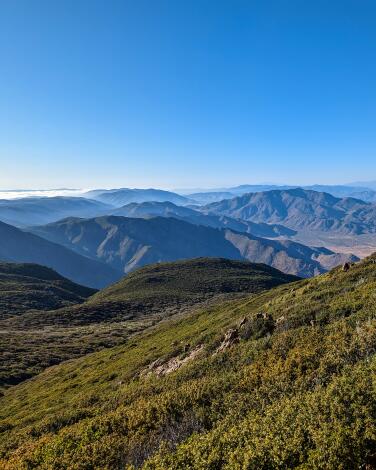
(Matt Pawlik)
Mountains or desert? Yes. Sitting at 6,000 feet on the edge of the steep escarpment, Garnet Peak in the Laguna Mountains overlooks the Anza-Borrego desert floor and offers some of the most dramatic views in the county.
Find the Penny Pines Trailhead on the eastern side of the Sunrise Highway to start your trek and make a left at the junction to go north along the famous Pacific Crest Trail. In springtime, you’ll find a flurry of wildflowers — look for dazzling arrays of the purple-blue lupine blooms — but it’s a beautiful trek year-round. Vistas of the surrounding Lagunas are constant (look for prominent Monument Peak to the south) and to your east, you’ll start to catch glimpses of the barren desert expanse. At just past the 1.5-mile mark, head right on the ascending Garnet Peak Trail, which takes you to the summit via a rocky incline. Near the apex it gets a bit technical and quite windy, so tread carefully as you rock scramble to your new favorite viewpoint. At the top, celebrate your climb and perch on a boulder to awe at the epic panoramic view of the Anza-Borrego Desert — the steep drop-offs here make it especially dramatic. In the other direction, you can also enjoy gorgeous scenes of the forested Laguna plateau and Cuyamaca Mountains.
Park in the paved pullout; dogs allowed. Start at the Pacific Crest Trail via Penny Pines Trailhead.
Find the Penny Pines Trailhead on the eastern side of the Sunrise Highway to start your trek and make a left at the junction to go north along the famous Pacific Crest Trail. In springtime, you’ll find a flurry of wildflowers — look for dazzling arrays of the purple-blue lupine blooms — but it’s a beautiful trek year-round. Vistas of the surrounding Lagunas are constant (look for prominent Monument Peak to the south) and to your east, you’ll start to catch glimpses of the barren desert expanse. At just past the 1.5-mile mark, head right on the ascending Garnet Peak Trail, which takes you to the summit via a rocky incline. Near the apex it gets a bit technical and quite windy, so tread carefully as you rock scramble to your new favorite viewpoint. At the top, celebrate your climb and perch on a boulder to awe at the epic panoramic view of the Anza-Borrego Desert — the steep drop-offs here make it especially dramatic. In the other direction, you can also enjoy gorgeous scenes of the forested Laguna plateau and Cuyamaca Mountains.
Park in the paved pullout; dogs allowed. Start at the Pacific Crest Trail via Penny Pines Trailhead.
Show more Show less
Route Details
Volcan Mountain
San Diego County Mountain Trail
5.2-mile out-and-back
Moderate
1,200 feet

(Matt Pawlik)
Picturesque Julian is known for its famous apple pies, but it’s also home to one of the most incredible hikes in the county. Enter Volcan Mountain, a 5,353-foot summit nestled in the Volcan Mountain Wilderness Preserve just north of town, offering rolling grassy hillsides, dense groves of oaks and conifers, and stunning views from the desert to the coast.
Start your hike on a gravel road passing an apple farm and enter the preserve through its unique gateway designed by local artist James Hubbell. At the first trail junction, take a right onto the Five Oaks Trail, a longer, narrower approach through the namesake trees (look for canyon, black and interior live varieties), and check out views of Julian and Cuyamaca as you ascend. As you rejoin the main fire road, you’ll soon be deposited in an expansive grassy meadow — look for coyotes and deer in the early mornings — and pass by stone ruins of an old astronomer outpost. Just before the trail splits and loops around the peak, look for a viewpoint on your left. Here you’ll find a log bench and an absolutely stunning overlook of the Anza-Borrego Desert to the east. At the peak, enjoy vistas of the Palomars to the north and to the west, the Santa Ysabel Valley and even the coast on a clear day.
Park on the dirt shoulder just off paved Farmer Road; dogs allowed. Start at the Volcan Mountain Trailhead on the eastern side of the road.
Start your hike on a gravel road passing an apple farm and enter the preserve through its unique gateway designed by local artist James Hubbell. At the first trail junction, take a right onto the Five Oaks Trail, a longer, narrower approach through the namesake trees (look for canyon, black and interior live varieties), and check out views of Julian and Cuyamaca as you ascend. As you rejoin the main fire road, you’ll soon be deposited in an expansive grassy meadow — look for coyotes and deer in the early mornings — and pass by stone ruins of an old astronomer outpost. Just before the trail splits and loops around the peak, look for a viewpoint on your left. Here you’ll find a log bench and an absolutely stunning overlook of the Anza-Borrego Desert to the east. At the peak, enjoy vistas of the Palomars to the north and to the west, the Santa Ysabel Valley and even the coast on a clear day.
Park on the dirt shoulder just off paved Farmer Road; dogs allowed. Start at the Volcan Mountain Trailhead on the eastern side of the road.
Show more Show less
Route Details
Boucher Hill Fire Lookout
Mountain Trail
3.7-mile loop
Moderate
800 feet
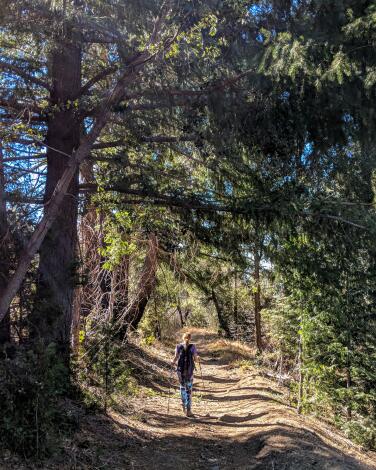
(Matt Pawlik)
Perched at 5,438 feet in the Palomar Mountains and in operation since 1921, the Boucher Hill Fire Lookout is one of just three such active towers in the county. Visiting is a great way to remind ourselves of the importance of fire prevention in Southern California (volunteers lead tours from May to December) while enjoying magnificent panoramic vistas over the Pauma Valley and even to the Pacific on clear days.
From the Silvercrest picnic area, which offers incredible views over the valley to the south via its own loop trail and a majestic 400-year-old incense cedar, head back to State Park Road and turn left, walking past Scott’s Cabin Trailhead on the right (where you’ll finish the trek) to a five-way junction. Pass the gate straight ahead to the narrow dirt Boucher Trail that leads steeply uphill under black oaks, firs and cedars to the tower. After savoring the views and checking out the tower, continue north on the loop and connect with the Adams Trail, which passes some impressive meadows and deposits you at the Cedar Grove Campground. Here, take Scott’s Cabin Trail east, which will pass old homesteader ruins and complete the loop.
If you’re looking for more mileage, consider hopping on the Cedar Trail, which takes you to serene Doane Pond and connects with the larger Thunder Springs and Chimney Flats loop back to Silvercrest. Consider hiking in the autumn for some stunning fall foliage and check out nearby Palomar Observatory.
Park in the paved lot at the Silvercrest picnic area; no dogs on trails. Start on State Park Road, heading west to the Boucher Hill Trail.
From the Silvercrest picnic area, which offers incredible views over the valley to the south via its own loop trail and a majestic 400-year-old incense cedar, head back to State Park Road and turn left, walking past Scott’s Cabin Trailhead on the right (where you’ll finish the trek) to a five-way junction. Pass the gate straight ahead to the narrow dirt Boucher Trail that leads steeply uphill under black oaks, firs and cedars to the tower. After savoring the views and checking out the tower, continue north on the loop and connect with the Adams Trail, which passes some impressive meadows and deposits you at the Cedar Grove Campground. Here, take Scott’s Cabin Trail east, which will pass old homesteader ruins and complete the loop.
If you’re looking for more mileage, consider hopping on the Cedar Trail, which takes you to serene Doane Pond and connects with the larger Thunder Springs and Chimney Flats loop back to Silvercrest. Consider hiking in the autumn for some stunning fall foliage and check out nearby Palomar Observatory.
Park in the paved lot at the Silvercrest picnic area; no dogs on trails. Start on State Park Road, heading west to the Boucher Hill Trail.
Show more Show less
Route Details
Cuyamaca Peak
San Diego County Mountain Trail
5.6-mile out-and-back
Strenuous
1,700 feet
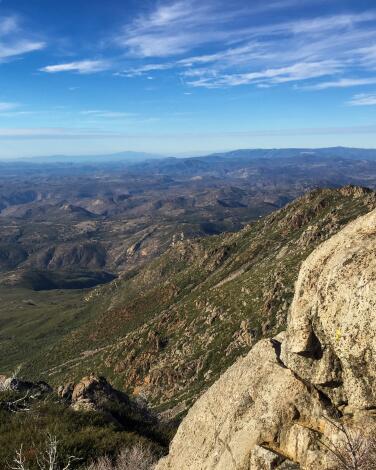
(Matt Pawlik)
At 6,512 feet, Cuyamaca Peak in Cuyamaca Rancho State Park is the second highest in San Diego, but it rewards with first-place views. The apex is just 20 feet lower than Hot Springs Mountain, and it’s also a far easier hike. That’s not to say it isn’t a leg-buster — the 1,700-foot grind to the summit is a slog, but what awaits at the top is worth every step.
Park in the day-use area at Paso Picacho Campground and look for Site 69 (and the charming coulter and cedar cabins) to find the paved trailhead, listening for resident redheaded woodpeckers along the way. You’ll take this all the way up. As you ascend, take a breather to enjoy your surroundings — look to the east for Stonewall Peak, Anza-Borrego, Lake Cuyamaca and even the Salton Sea. You’ll also notice some lasting effects of the massive 2003 Cedar Fire as well as promising signs of recovery. As you near the peak, a dense forest appears out of nowhere, filled with impressive sugar pines alongside white firs, cedars and oaks. Once you’ve made it, plop down on a boulder and soak it all in. Epic panoramas stretch northward past Mt. Palomar all the way to Mt. Baldy, west to San Diego proper and Catalina Island and even south to the peaks of northern Mexico. It’s one of the most inspiring lookouts in all of Southern California, especially on a clear, post-storm winter day. Sign the logbook in celebration and prepare your knees for the descent.
Park in the paved lot at the day use area of Paso Picacho Campground; dogs allowed only on paved trails in Cuyamaca Rancho State Park. Start on Lookout Road, heading west.
Park in the day-use area at Paso Picacho Campground and look for Site 69 (and the charming coulter and cedar cabins) to find the paved trailhead, listening for resident redheaded woodpeckers along the way. You’ll take this all the way up. As you ascend, take a breather to enjoy your surroundings — look to the east for Stonewall Peak, Anza-Borrego, Lake Cuyamaca and even the Salton Sea. You’ll also notice some lasting effects of the massive 2003 Cedar Fire as well as promising signs of recovery. As you near the peak, a dense forest appears out of nowhere, filled with impressive sugar pines alongside white firs, cedars and oaks. Once you’ve made it, plop down on a boulder and soak it all in. Epic panoramas stretch northward past Mt. Palomar all the way to Mt. Baldy, west to San Diego proper and Catalina Island and even south to the peaks of northern Mexico. It’s one of the most inspiring lookouts in all of Southern California, especially on a clear, post-storm winter day. Sign the logbook in celebration and prepare your knees for the descent.
Park in the paved lot at the day use area of Paso Picacho Campground; dogs allowed only on paved trails in Cuyamaca Rancho State Park. Start on Lookout Road, heading west.
Show more Show less
Route Details
The Slot
San Diego County Canyon Trail
2.3-mile loop
Moderate
300 feet
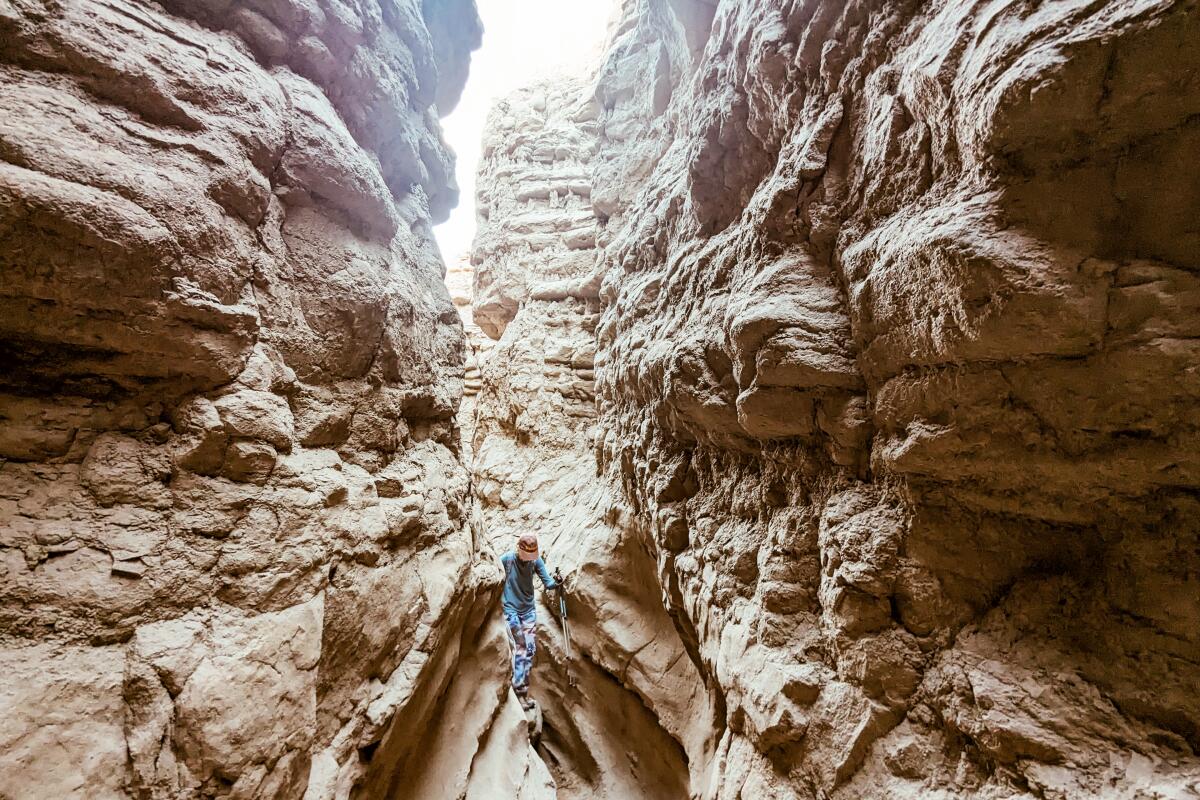
(Matt Pawlik)
At more than 600,000 acres, Anza-Borrego Desert State Park represents a fifth of San Diego County and is the second largest state park in the country. In short, it’s huge. So where should first-time visitors go? Straight to the otherworldly trail known as the Slot.
Park in the dirt lot (arrive early to beat the crowds) and find the trailhead near the no dogs sign and head northeast. After a small incline, enjoy the sprawling badland views and make two lefts to head west into the ravine — you can actually continue east here on the West Butte trail all the way to Borrego Mountain (1,201 feet) if you seek additional adventure. As you descend into the siltstone trench, it feels like you are entering an alien planet. The nearly 50-foot siltstone canyon walls surrounding you become narrower and narrower, and you may have to remove your backpack to navigate some of the technical twists and turns. Rock slabs above you defy gravity, adding a picturesque frame to the experience and your photos. After about half a mile, the canyon walls expand as you are deposited into a wide wash dotted with desert shrubs. If you’re with kids, it might be a good idea to head back through the slot to your car. Otherwise, continue north to the next trail junction, an incredibly steep dirt road called the “Drop Off.” It’s hard to imagine 4x4s careening down it as you climb the impossibly steep grade, but the panoramic vistas are worth the workout as you rejoin the Borrego Mountain Wash Road. The relatively flat path takes you one mile back to the lot, with views of the slot canyon below and the sprawling desert valley throughout. On your next trip to Anza-Borrego, slot this hike in.
Park in the dirt lot at the Slot trailhead off Borrego Mountain Wash Road; no dogs allowed on the trail. Start on the Slot trail, heading east.
Park in the dirt lot (arrive early to beat the crowds) and find the trailhead near the no dogs sign and head northeast. After a small incline, enjoy the sprawling badland views and make two lefts to head west into the ravine — you can actually continue east here on the West Butte trail all the way to Borrego Mountain (1,201 feet) if you seek additional adventure. As you descend into the siltstone trench, it feels like you are entering an alien planet. The nearly 50-foot siltstone canyon walls surrounding you become narrower and narrower, and you may have to remove your backpack to navigate some of the technical twists and turns. Rock slabs above you defy gravity, adding a picturesque frame to the experience and your photos. After about half a mile, the canyon walls expand as you are deposited into a wide wash dotted with desert shrubs. If you’re with kids, it might be a good idea to head back through the slot to your car. Otherwise, continue north to the next trail junction, an incredibly steep dirt road called the “Drop Off.” It’s hard to imagine 4x4s careening down it as you climb the impossibly steep grade, but the panoramic vistas are worth the workout as you rejoin the Borrego Mountain Wash Road. The relatively flat path takes you one mile back to the lot, with views of the slot canyon below and the sprawling desert valley throughout. On your next trip to Anza-Borrego, slot this hike in.
Park in the dirt lot at the Slot trailhead off Borrego Mountain Wash Road; no dogs allowed on the trail. Start on the Slot trail, heading east.
Show more Show less
Route Details
Calcite Mine
Mountain Trail
4.3-mile loop
Moderate
700 feet

(Matt Pawlik)
With panoramic vistas, unique geological wonders, interesting historical remnants and wildflower blooms in spring, the remote hike to Calcite Mine is a bona-fide Borrego highlight reel.
Nestled in the eastern edge of the state park on the southern spurs of the Santa Rosa Mountains, the less-traveled Calcite Mine Trail starts with a steep descent down a treacherous 4x4 road into Palm Wash, which can also be explored via an eight-mile loop, and then quickly ascends above the canyon floor. At the 0.6-mile mark, a spur trail heads right back into the ravine, where you can explore a slot canyon and reconnect with the main dirt road at the 1.4-mile mark. After another half a mile, you reach the site of an old calcite mine, marked by interpretive signage. You may be able to spot sparkling bits of the mineral, which was important during World War II in the manufacturing of Norden bombsights. While the history is fascinating, the views here are unreal, stretching from the surrounding mountains to Borrego Badlands to the south and even the Salton Sea to the east. In the spring, desert lilies dot the valley floor. It’s the perfect spot for a picnic and solitary desert reflection. Before leaving, don’t miss the jagged geological specimen that is locomotive rock, an impressively large sandstone slab with intricate cavities just northeast of the mine.
Park on the dirt shoulder on the side of the paved Borrego Salton Sea Way (S22); no dogs allowed on the trail.
Nestled in the eastern edge of the state park on the southern spurs of the Santa Rosa Mountains, the less-traveled Calcite Mine Trail starts with a steep descent down a treacherous 4x4 road into Palm Wash, which can also be explored via an eight-mile loop, and then quickly ascends above the canyon floor. At the 0.6-mile mark, a spur trail heads right back into the ravine, where you can explore a slot canyon and reconnect with the main dirt road at the 1.4-mile mark. After another half a mile, you reach the site of an old calcite mine, marked by interpretive signage. You may be able to spot sparkling bits of the mineral, which was important during World War II in the manufacturing of Norden bombsights. While the history is fascinating, the views here are unreal, stretching from the surrounding mountains to Borrego Badlands to the south and even the Salton Sea to the east. In the spring, desert lilies dot the valley floor. It’s the perfect spot for a picnic and solitary desert reflection. Before leaving, don’t miss the jagged geological specimen that is locomotive rock, an impressively large sandstone slab with intricate cavities just northeast of the mine.
Park on the dirt shoulder on the side of the paved Borrego Salton Sea Way (S22); no dogs allowed on the trail.
Show more Show less
Route Details
Hellhole Canyon
San Diego County Canyon Trail
5.0-mile out-and-back
Moderate
1,000 feet
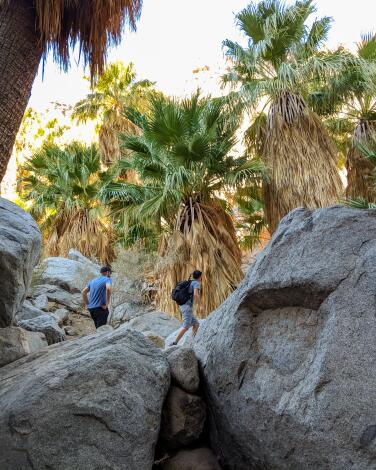
(Matt Pawlik)
Hellhole Canyon in Anza-Borrego Desert State Park, whose name comes from a cattleman’s observation that it was “one hell of a hole to get cattle out of,” culminates at a beautiful palm oasis with a 20-foot waterfall. And it’s far less visited than the nearby popular Borrego Palm Canyon trek.
The trail starts ominously, passing a faux grave of those who failed to bring enough water (so bring plenty), but it is mostly flat for the first two miles, passing a junction with the California Riding and Hiking Trail and winding around barrel cactuses, creosote, ocotillo and yucca. In the springtime, wildflower blooms like desert dandelion and phacelia dot the canyon floor. The path begins to narrow and offers some technical rock scrambling as you reach the first palm grove, complemented by cottonwoods and sycamores. Listen for the chirping of yellow-faced verdins in the brush or try to spot the striking black-throated sparrows dancing among the flora as you continue on to a denser second palm oasis. This is a great spot to perch on a rock for a picnic or climb out of the oasis to scan the canyon cliffs for the park’s eponymous star (Borrego is a Spanish word for “sheep” or “lamb”): the peninsular bighorn sheep. We recommend doing the hike at sunrise or sunset for your best chance to catch the regal mammals. Continue rock scrambling for another quarter-mile to get to the falls.
Park in the dirt lot on the side of the paved Montezuma Borrego Highway (S22); no dogs allowed on the trail. Start on Hellhole Canyon Trail, heading west.
The trail starts ominously, passing a faux grave of those who failed to bring enough water (so bring plenty), but it is mostly flat for the first two miles, passing a junction with the California Riding and Hiking Trail and winding around barrel cactuses, creosote, ocotillo and yucca. In the springtime, wildflower blooms like desert dandelion and phacelia dot the canyon floor. The path begins to narrow and offers some technical rock scrambling as you reach the first palm grove, complemented by cottonwoods and sycamores. Listen for the chirping of yellow-faced verdins in the brush or try to spot the striking black-throated sparrows dancing among the flora as you continue on to a denser second palm oasis. This is a great spot to perch on a rock for a picnic or climb out of the oasis to scan the canyon cliffs for the park’s eponymous star (Borrego is a Spanish word for “sheep” or “lamb”): the peninsular bighorn sheep. We recommend doing the hike at sunrise or sunset for your best chance to catch the regal mammals. Continue rock scrambling for another quarter-mile to get to the falls.
Park in the dirt lot on the side of the paved Montezuma Borrego Highway (S22); no dogs allowed on the trail. Start on Hellhole Canyon Trail, heading west.
Show more Show less
Route Details
Woodson Mountain and Potato Chip Rock
San Diego County Mountain Trail
7.4-mile out-and-back
Strenuous
2,000 feet
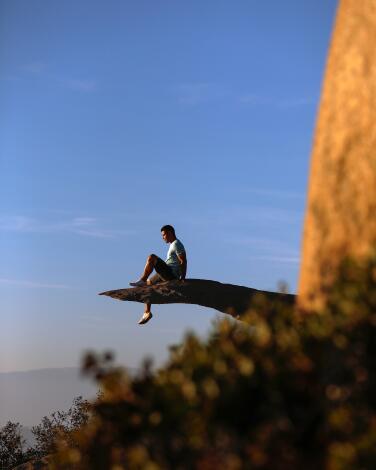
(Christina House / Los Angeles Times)
Potato Chip Rock has become an unofficial symbol of San Diego hiking through its social media stardom. Perched near the summit of Woodson Mountain in Poway and named by San Diego hiking legend Jerry Schad, the large granite flake juts precariously over the rocky edge of the mountain. And while many make the trek just for the cool photo op, the prominent 2,901-foot Woodson Mountain also offers some of the most impressive western-facing views in the county.
Start your leg-busting workout on a serene path that flanks the western shore of Lake Poway, a massive reservoir with year-round fishing. At nearly the three-quarter-mile mark, you’ll head right at the junction and start your arduous climb. You’ll encounter lookout points and benches along the way, perfect to take a breather and enjoy the expanding views of the lake and surrounding suburbia stretching to downtown San Diego. At 1.8 miles, leave the fire road, heading on the left route that maneuvers through mazes of huge granite boulders of all shapes and sizes. As you near the summit and the dirt path becomes paved, look for Potato Chip Rock (and likely a line of eager hikers, unless you’ve started early) on your left. Though there isn’t a true summit, an additional quarter-mile delivers you to the radio tower site with plenty of spots to sit and enjoy the incredible views away from the crowds. Look for neighboring Iron Mountain (another fantastic local hike) to the south and all the way to the Pacific to the west on a clear day.
Park in the paved lot off Lake Poway Road; dog-friendly. Start on Woodson Mountain Trail, heading west along the lake.
Start your leg-busting workout on a serene path that flanks the western shore of Lake Poway, a massive reservoir with year-round fishing. At nearly the three-quarter-mile mark, you’ll head right at the junction and start your arduous climb. You’ll encounter lookout points and benches along the way, perfect to take a breather and enjoy the expanding views of the lake and surrounding suburbia stretching to downtown San Diego. At 1.8 miles, leave the fire road, heading on the left route that maneuvers through mazes of huge granite boulders of all shapes and sizes. As you near the summit and the dirt path becomes paved, look for Potato Chip Rock (and likely a line of eager hikers, unless you’ve started early) on your left. Though there isn’t a true summit, an additional quarter-mile delivers you to the radio tower site with plenty of spots to sit and enjoy the incredible views away from the crowds. Look for neighboring Iron Mountain (another fantastic local hike) to the south and all the way to the Pacific to the west on a clear day.
Park in the paved lot off Lake Poway Road; dog-friendly. Start on Woodson Mountain Trail, heading west along the lake.
Show more Show less
Route Details
North and South Fortuna Mountains
San Diego Mountain Trail
7.4-mile loop
Strenuous
1,500 feet
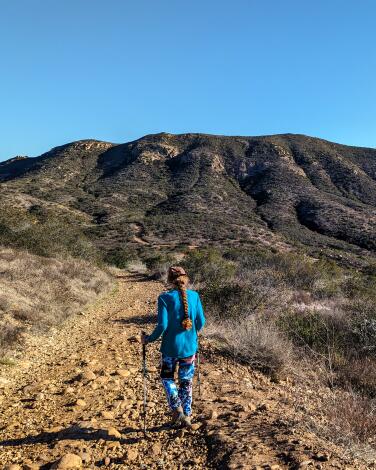
(Matt Pawlik)
Encompassing nearly 8,000 acres and 65 miles of trails, Mission Trails Regional Park is the central hub for outdoor recreation in San Diego and the largest municipally owned park in California. It’s not a place you visit just once — it’s got the highest peak in the city (Cowles Mountain), a historic dam, a portion of the San Diego River, a lakeside campground and a state-of-the-art visitor center — but for your first half-day visit, opt for a double-peak adventure that tours the western side of the expansive preserve.
North (1,293 feet) and South (1,094 feet) Fortuna Mountains were part of the famous 5-Peak Challenge and can be conquered together. Plus, these trails experience a lot less traffic than nearby Cowles Mountain. Starting from the West Fortuna Staging Area, cross the scenic bridge over the canyon and make a left onto the Clairemont Mesa Trail. You’ll wind up on the Rim Trail. Here, on the saddle, the canyon vistas are phenomenal. Continue parallel to the 52 Freeway, but be careful — when you make a right onto the final ascent to your first peak, the trail gets steep and rocky. The reward is well worth the challenge as you reach the summit of North Fortuna with epic views of the park — the San Diego River Valley, Kumeyaay Lake (named after the Indigenous people who called this area home) and the rolling hills are all highlights — as well as the surrounding city stretching to the downtown skyline and Coronado Bridge. South Fortuna summit is one mile away, and the panoramas are just as impressive.
As you descend south along the steep steps, look to your left into the canyon to see if you can spot climbers on the sheer, rocky cliffs (a great short hike near the visitor center). Continue on the trail and follow signs for Fortuna Saddle, passing briefly through a welcoming riparian section with large oaks providing a shady respite. At the four-way junction, make a sharp right onto Fortuna Saddle followed by an immediate left to complete the loop back to the staging area and your car.
Park in the paved lot off Clairemont Mesa Boulevard; dog-friendly. Start on Fortuna Trail, at the eastern end of the parking lot.
North (1,293 feet) and South (1,094 feet) Fortuna Mountains were part of the famous 5-Peak Challenge and can be conquered together. Plus, these trails experience a lot less traffic than nearby Cowles Mountain. Starting from the West Fortuna Staging Area, cross the scenic bridge over the canyon and make a left onto the Clairemont Mesa Trail. You’ll wind up on the Rim Trail. Here, on the saddle, the canyon vistas are phenomenal. Continue parallel to the 52 Freeway, but be careful — when you make a right onto the final ascent to your first peak, the trail gets steep and rocky. The reward is well worth the challenge as you reach the summit of North Fortuna with epic views of the park — the San Diego River Valley, Kumeyaay Lake (named after the Indigenous people who called this area home) and the rolling hills are all highlights — as well as the surrounding city stretching to the downtown skyline and Coronado Bridge. South Fortuna summit is one mile away, and the panoramas are just as impressive.
As you descend south along the steep steps, look to your left into the canyon to see if you can spot climbers on the sheer, rocky cliffs (a great short hike near the visitor center). Continue on the trail and follow signs for Fortuna Saddle, passing briefly through a welcoming riparian section with large oaks providing a shady respite. At the four-way junction, make a sharp right onto Fortuna Saddle followed by an immediate left to complete the loop back to the staging area and your car.
Park in the paved lot off Clairemont Mesa Boulevard; dog-friendly. Start on Fortuna Trail, at the eastern end of the parking lot.
Show more Show less
Route Details
Boulder Loop at Daley Ranch
Escondido Park Trail
5.3-mile loop
Moderate
800 feet
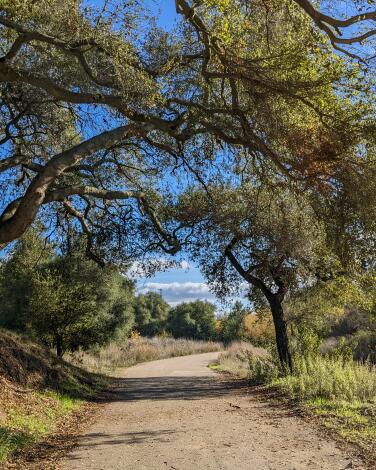
(Matt Pawlik)
Phenomenal views and impressive geology? Check. Rare trees and secret ponds? Check again. Sprinkle in a historic home and you’ve got a top-tier trek. With more than 3,200 acres of grassland, riparian, oak woodland, coastal sage scrub and chaparral areas, Daley Ranch in Escondido is a North County haven for hikers.
Get yourself acquainted via the Boulder Loop, starting on a paved path under the ranch gate sign (ignoring the dirt trail to the right, a great hike to the park’s high point, Stanley Peak). You’ll immediately have expansive vistas of Escondido to the south. At just past the half-mile mark, you‘ll reach an peaceful overlook of Middle Pond, most likely dotted with coots, ducks, egrets and cormorants. Pass by the junction for Boulder Loop for now to quickly check out the historic Daley Ranch house (open on the second Sunday of the month for tours). Back on the loop, you’ll pass under giant Engelmann and coast live oaks before being deposited into open grassy meadows. Passing giant granite specimens that inevitably gave this trail its name, it’s a great workout with greater rewards. The vistas of the surrounding rolling hills are gorgeous and can be viewed on a bench under a shade structure at the apex of the loop.
Park in the dirt lot off La Honda Drive; dog-friendly. Start on Ranch House Road, at the northern end of the parking lot.
Get yourself acquainted via the Boulder Loop, starting on a paved path under the ranch gate sign (ignoring the dirt trail to the right, a great hike to the park’s high point, Stanley Peak). You’ll immediately have expansive vistas of Escondido to the south. At just past the half-mile mark, you‘ll reach an peaceful overlook of Middle Pond, most likely dotted with coots, ducks, egrets and cormorants. Pass by the junction for Boulder Loop for now to quickly check out the historic Daley Ranch house (open on the second Sunday of the month for tours). Back on the loop, you’ll pass under giant Engelmann and coast live oaks before being deposited into open grassy meadows. Passing giant granite specimens that inevitably gave this trail its name, it’s a great workout with greater rewards. The vistas of the surrounding rolling hills are gorgeous and can be viewed on a bench under a shade structure at the apex of the loop.
Park in the dirt lot off La Honda Drive; dog-friendly. Start on Ranch House Road, at the northern end of the parking lot.
Show more Show less
Route Details
Cedar Creek Falls
San Diego County Mountain Trail
5.4-mile out-and-back
Strenuous
1,100 feet
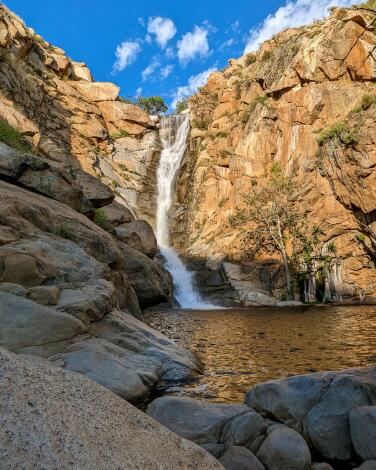
(Matt Pawlik)
From Horsethief Canyon to the flowing two-tiered cascade of Three Sisters Falls, San Diego County has plenty of watering hole hikes, but one stands tall above the rest. The 80-foot Cedar Creek Falls in Ramona thunder into a gorgeous, cottonwood-framed punch bowl that make it one of the best hiking destinations in SoCal, so much so that it was once subject to raucous partying and vandalism. However, since 2014, a daily limit permit system has been in place. The trail is now in pristine condition, with regular trail signage and shaded benches to rest.
Start your switchback descent into the San Diego River Gorge, enjoying epic vistas of the surrounding mountains along the way. On the canyon floor, the environment immediately changes as riparian features start to explode around you — enjoy the shade of willows, cottonwoods, coast live oaks and sycamores as you navigate a couple creek crossings. You’ll soon hear the falls and perhaps the voices of fellow hikers. Come after it rains to catch the water at its strongest flow and bring your swimsuit for a refreshing, albeit frigid, mid-hike dip. Even if you don’t go for a swim, the towering falls are impressive to behold, and you certainly won’t want to hurry to leave — it’s all uphill on the way back.
Park in the paved lot off Thornbush Road dog-friendly. Start on the Cedar Creek Falls trail across from the lot, on the eastern side of the road.
Start your switchback descent into the San Diego River Gorge, enjoying epic vistas of the surrounding mountains along the way. On the canyon floor, the environment immediately changes as riparian features start to explode around you — enjoy the shade of willows, cottonwoods, coast live oaks and sycamores as you navigate a couple creek crossings. You’ll soon hear the falls and perhaps the voices of fellow hikers. Come after it rains to catch the water at its strongest flow and bring your swimsuit for a refreshing, albeit frigid, mid-hike dip. Even if you don’t go for a swim, the towering falls are impressive to behold, and you certainly won’t want to hurry to leave — it’s all uphill on the way back.
Park in the paved lot off Thornbush Road dog-friendly. Start on the Cedar Creek Falls trail across from the lot, on the eastern side of the road.
Show more Show less
Route Details
Los Peñasquitos Canyon County Preserve
San Diego Canyon Trail
6.8-mile loop
Easy
160 feet
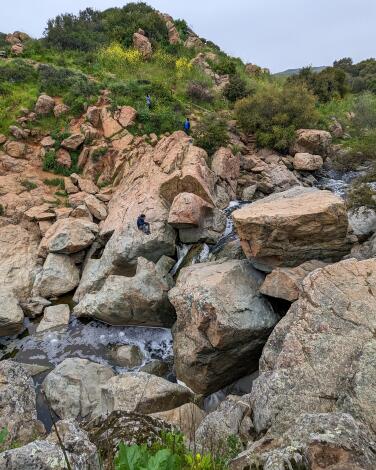
(Matt Pawlik)
Jointly operated by the city and the county, the 4,000-acre Los Peñasquitos Canyon County Preserve is a shining example of how a natural respite among an urban area can be protected and enjoyed. Stretching seven miles between San Diego’s two major highways (I-5 and I-15), the preserve boasts numerous entry points and mostly gentle terrain that attracts all levels of hikers, bikers and equestrians, not to mention connections to the neighboring Carmel Mountain and Del Mar Mesa preserves.
Though any path will delight, start at the southeastern-most trailhead off Black Mountain Road and head east along peaceful Peñasquitos Creek. It’s easy to take spur trails or cross the creek, but stay south to complete a simple loop. Along the way, you’ll encounter beautiful open grassy meadows, lush rolling hills and dense riparian environments, chalk full of towering California live oaks and sycamores. The variety of flora and fauna is impressive, with more than 500 plant species and 175 birds, and you very well may see mule deer heading to the creek for a drink. At about the 3.3-mile mark, you reach the preserve’s prime feature: a flowing cascade through large volcanic rocks. It’s the perfect lunch spot and crossing point as you head back on the northern side of the creek.
On the return trip, make a pit stop at the Rancho de los Peñasquitos Adobe (there are tours at 11 a.m. Saturdays and 1 p.m. Sundays), which houses farm animals and a small museum dedicated to the 7,000 years of history here, from remnants of the La Jolla and Kumeyaay people to its significance as the first Mexican land grant in San Diego. On your next trip, consider starting from the western side to explore more of what this beautiful preserve has to offer.
Park in the paved lot off Black Mountain Road; dog-friendly. Start on the Los Peñasquitos Canyon Trail at the northwestern end of the lot, heading west.
Though any path will delight, start at the southeastern-most trailhead off Black Mountain Road and head east along peaceful Peñasquitos Creek. It’s easy to take spur trails or cross the creek, but stay south to complete a simple loop. Along the way, you’ll encounter beautiful open grassy meadows, lush rolling hills and dense riparian environments, chalk full of towering California live oaks and sycamores. The variety of flora and fauna is impressive, with more than 500 plant species and 175 birds, and you very well may see mule deer heading to the creek for a drink. At about the 3.3-mile mark, you reach the preserve’s prime feature: a flowing cascade through large volcanic rocks. It’s the perfect lunch spot and crossing point as you head back on the northern side of the creek.
On the return trip, make a pit stop at the Rancho de los Peñasquitos Adobe (there are tours at 11 a.m. Saturdays and 1 p.m. Sundays), which houses farm animals and a small museum dedicated to the 7,000 years of history here, from remnants of the La Jolla and Kumeyaay people to its significance as the first Mexican land grant in San Diego. On your next trip, consider starting from the western side to explore more of what this beautiful preserve has to offer.
Park in the paved lot off Black Mountain Road; dog-friendly. Start on the Los Peñasquitos Canyon Trail at the northwestern end of the lot, heading west.
Show more Show less
Route Details
La Jolla Beach Trail
San Diego Coastal Trail
2.5-mile out-and-back
Easy
200 feet

(Matt Pawlik)
There is no shortage of coastal beauty in San Diego. From the rocky San Onofre Bluffs to the undeveloped dunes and salt marshes of the currently closed Border Field State Park, every stretch is different and worth visiting. One particular sliver may be the most famous, though, and for good reason. La Jolla has tide pools, sea caves, sea cliffs, famous marine mammal residents and those unparalleled shoreline views.
Start at the tide pools (best explored in winter), peeking into the microecosystems to find sea anemones, sculpin and hermit crabs, and then head north. Pass plots of vibrant nasturtiums and ample lawn space as you continue north on the sidewalk, passing multiple sunset-ready gazebos and Children’s Pool, where you can spot harbor seals from a safe distance (closed through May 15 for seal pupping season). Continue into Ellen Browning Scripps Park, a palm tree–lined oasis often deemed the most photographed spot in San Diego and a great space to watch for seagulls and pelicans, followed by La Jolla Cove. Here is where you can view the famous sea lions basking in the sun or wrestling for social hierarchy. It’s an incredible sight but also a sensitive habitat, so be sure to give the sea lions plenty of space.
You can continue east here to explore the Sunny Jim Sea Cave (entry fee required) and north toward La Jolla Shores. If the tide is low and you’re feeling adventurous, you can keep going all the way to Torrey Pines, passing the Scripps Pier on the way to Black’s Beach (a well-known nude beach, so go at your own risk), which has stairs leading to the Torrey Gliderport.
Start at the tide pools (best explored in winter), peeking into the microecosystems to find sea anemones, sculpin and hermit crabs, and then head north. Pass plots of vibrant nasturtiums and ample lawn space as you continue north on the sidewalk, passing multiple sunset-ready gazebos and Children’s Pool, where you can spot harbor seals from a safe distance (closed through May 15 for seal pupping season). Continue into Ellen Browning Scripps Park, a palm tree–lined oasis often deemed the most photographed spot in San Diego and a great space to watch for seagulls and pelicans, followed by La Jolla Cove. Here is where you can view the famous sea lions basking in the sun or wrestling for social hierarchy. It’s an incredible sight but also a sensitive habitat, so be sure to give the sea lions plenty of space.
You can continue east here to explore the Sunny Jim Sea Cave (entry fee required) and north toward La Jolla Shores. If the tide is low and you’re feeling adventurous, you can keep going all the way to Torrey Pines, passing the Scripps Pier on the way to Black’s Beach (a well-known nude beach, so go at your own risk), which has stairs leading to the Torrey Gliderport.
Show more Show less
Route Details
Balboa Park Bridge Walk
San Diego Urban Trail
4.5-mile loop
Easy
350 feet
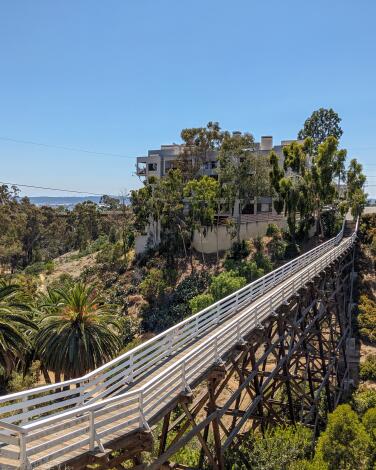
(Matt Pawlik)
In San Diego, there are plenty of opportunities to explore the intersection of nature and city life; a prime example starts at the region’s cultural hub: Balboa Park. Often described as the Smithsonian of the West, the 1,200-acre space hosts 16 museums, 17 gardens, plenty of hiking trails, a huge sports complex and, of course, the world famous San Diego Zoo. A San Diego native may never see it all.
Head to the park’s northwestern corner and start at the Trees for Health Garden, where an interpretive trail informs about medicinal plants and offers views of the iconic El Prado and across Balboa Park. To find your first bridge, head west two blocks on Quince Street to one of the few remaining pedestrian wooden trestles in Southern California. The bridge is quite a sight and also provides vistas of great scenery, stretching from Maple Canyon below to Coronado and the Pacific. Quince Street ends at 1st Avenue; take a right here, followed by a left at Spruce Street to return to suburbia and your next bridge: the cables of the 375-foot Spruce Street Suspension Bridge (built in 1912), a wondrous surprise in the Bankers Hill neighborhood. The bridge sways slightly under your feet as you walk over the rugged canyon below. Spruce offers fantastic cityscape views, but the main attraction is certainly the concrete structure itself, which is great for photos at all angles.
From here, we recommend heading back to Maple Canyon (trail entrance at Quince and 3rd Street) to hike the hidden canyon under the Quince Street Bridge and 1st Avenue Bridge (a.k.a. the People’s Bridge) down to its southern entrance at Maple Street. Take two quick lefts — at State Street and Laurel Street — and head east on Laurel, which takes you directly to El Prado and the Balboa Park entrance. Pass the prominent California Tower (yes, you can go up for a fee) and walk over Cabrillo Bridge, built in 1914 for the Panama-California Exposition as the state’s first multiple-arched cantilever bridge. You are now in the heart of Balboa Park. Take your time to explore the many museums and gardens (highly recommend the Japanese Friendship Garden and Desert Garden).
Park along Balboa Drive, near the intersection with Quince Street; dog-friendly. Check out the garden trails then head west on Quince Street.
Head to the park’s northwestern corner and start at the Trees for Health Garden, where an interpretive trail informs about medicinal plants and offers views of the iconic El Prado and across Balboa Park. To find your first bridge, head west two blocks on Quince Street to one of the few remaining pedestrian wooden trestles in Southern California. The bridge is quite a sight and also provides vistas of great scenery, stretching from Maple Canyon below to Coronado and the Pacific. Quince Street ends at 1st Avenue; take a right here, followed by a left at Spruce Street to return to suburbia and your next bridge: the cables of the 375-foot Spruce Street Suspension Bridge (built in 1912), a wondrous surprise in the Bankers Hill neighborhood. The bridge sways slightly under your feet as you walk over the rugged canyon below. Spruce offers fantastic cityscape views, but the main attraction is certainly the concrete structure itself, which is great for photos at all angles.
From here, we recommend heading back to Maple Canyon (trail entrance at Quince and 3rd Street) to hike the hidden canyon under the Quince Street Bridge and 1st Avenue Bridge (a.k.a. the People’s Bridge) down to its southern entrance at Maple Street. Take two quick lefts — at State Street and Laurel Street — and head east on Laurel, which takes you directly to El Prado and the Balboa Park entrance. Pass the prominent California Tower (yes, you can go up for a fee) and walk over Cabrillo Bridge, built in 1914 for the Panama-California Exposition as the state’s first multiple-arched cantilever bridge. You are now in the heart of Balboa Park. Take your time to explore the many museums and gardens (highly recommend the Japanese Friendship Garden and Desert Garden).
Park along Balboa Drive, near the intersection with Quince Street; dog-friendly. Check out the garden trails then head west on Quince Street.
Show more Show less
Route Details
Sunset Cliffs
San Diego Coastal Trail
2.5-mile out-and-back
Easy
100 feet
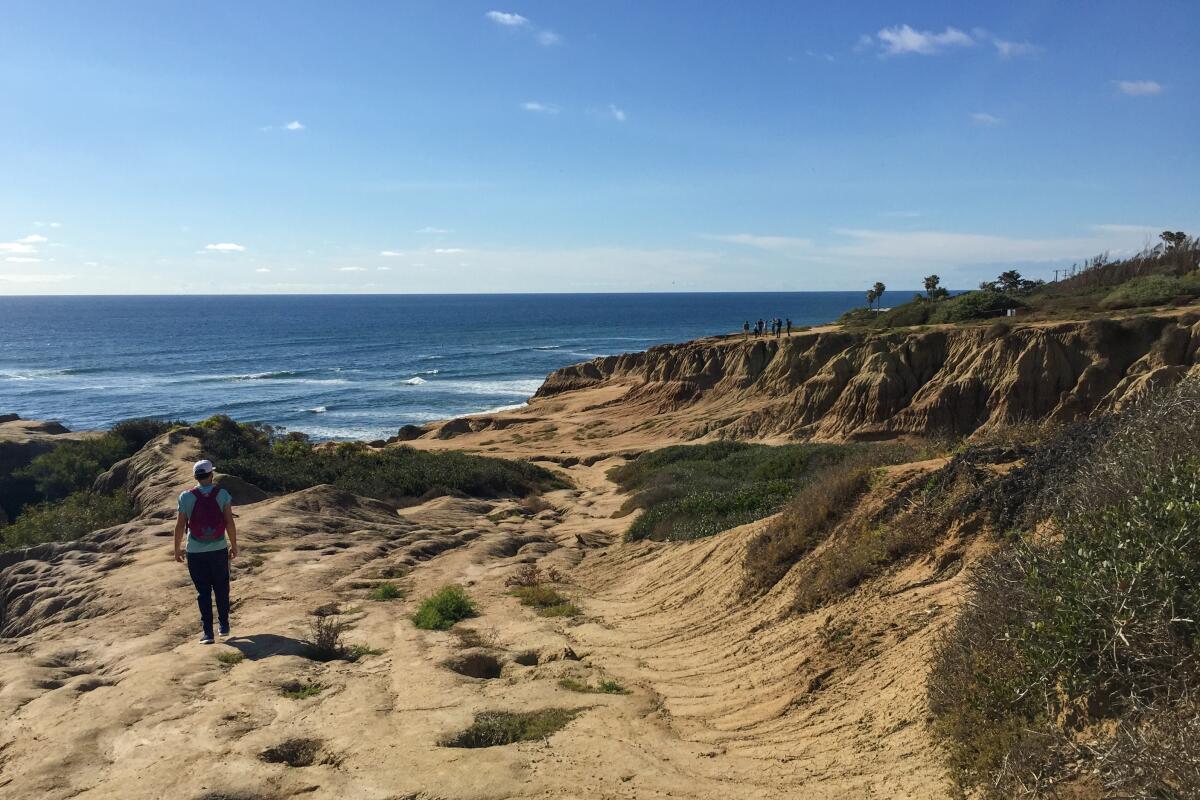
(Matt Pawlik)
There’s nothing quite like a San Diego sunset. Sunset Cliffs Natural Park in Point Loma is the perfect place for a golden hour stroll — and it’s less crowded than nearby Ocean Beach. Park at the upper lot off Lomaland Drive for the best views to start your hike, but you can also grab a spot at the lower lot or at the small lot at the northern end of the cliffs off Osprey Street. After exploring the small trail system in the 68-acre undeveloped preserve, head down steps and craggy cliff paths toward the coast, enjoying the striking panoramas of arches and views — look to the south to spot Coronado Island.
Continue past the lower parking lot as the trail meanders along the bluffs and reaches Sunset Cliffs Boulevard and Ladera Street. Here, there is beach staircase down to an intertidal oasis; otherwise, head north, enjoying constant views of the Pacific and San Diego coastline from the cliffs. You may have to walk on the street at times, depending on cliff erosion, so tread carefully and with respect to the fragility of nature. As you hug the precitipuios edges, look for sea caves below (some can be explored during low tide) and pods of pelicans soaring above. Most important, find a good spot to watch the sunset. Who knows? You might just catch the green flash. If you want to up your mileage (and beautiful coastal views), consider heading to nearby Cabrillo National Monument to check out its awesome tide pools and stunning 2.5-mile bay-side trail.
Park at the upper lot of Sunset Cliffs Natural Park, off Lomaland Drive. Head west on the trails toward the coast and connect with the path along Sunset Cliffs Boulevard.
Continue past the lower parking lot as the trail meanders along the bluffs and reaches Sunset Cliffs Boulevard and Ladera Street. Here, there is beach staircase down to an intertidal oasis; otherwise, head north, enjoying constant views of the Pacific and San Diego coastline from the cliffs. You may have to walk on the street at times, depending on cliff erosion, so tread carefully and with respect to the fragility of nature. As you hug the precitipuios edges, look for sea caves below (some can be explored during low tide) and pods of pelicans soaring above. Most important, find a good spot to watch the sunset. Who knows? You might just catch the green flash. If you want to up your mileage (and beautiful coastal views), consider heading to nearby Cabrillo National Monument to check out its awesome tide pools and stunning 2.5-mile bay-side trail.
Park at the upper lot of Sunset Cliffs Natural Park, off Lomaland Drive. Head west on the trails toward the coast and connect with the path along Sunset Cliffs Boulevard.
Show more Show less
Route Details
Hollenbeck Canyon Wildlife Area
San Diego County Canyon Trail
6.2-mile loop
Moderate
820 feet
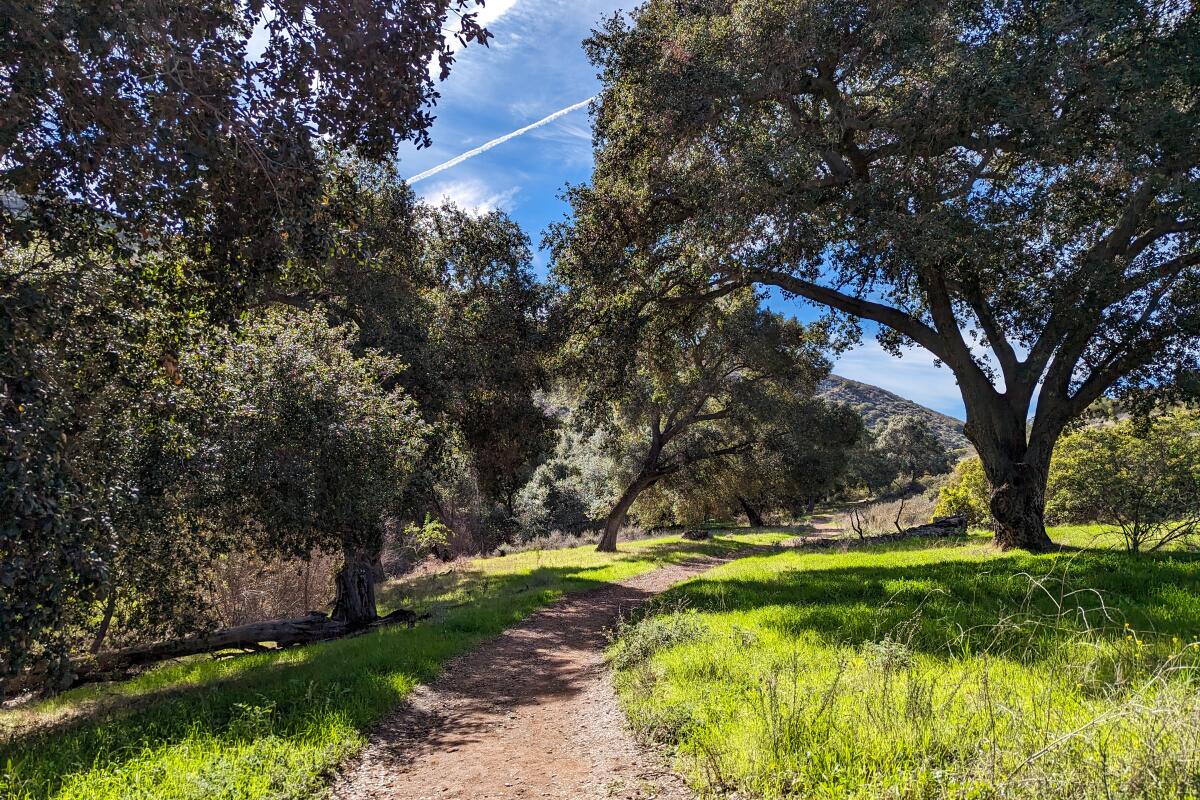
(Matt Pawlik)
During spring or after it rains, you can find rolling green hills and luscious grasslands to the likes of Austria or Scotland throughout east county — West Sycamore Canyon, the Ramona Grasslands Preserve and the Santa Ysabel Open Space Preserve come to mind. But one such star, the Hollenbeck Canyon Wildlife Area, has even more variety, with coastal sage scrub, chaparral, oak woodlands, riparian forests and freshwater marshes all viewable on a single trek. The California Department of Fish and Wildlife Lands Pass fee is more than worth it; its remote location in Jamul makes it less crowded too.
As you start on the Honey Springs Ranch Trail, you are immediately graced with vibrant green hills dotted with giant oaks — a truly serene sight. Turn right at the junction to begin your frolick into the canyon, where you’ll flank a stream with towering oaks and sycamores providing ample shade. Look for soaring red-tailed hawks over the meadows and perhaps even a deer, coyote or bobcat grabbing a drink at the babbling water. Don’t forget to look back as the views of the canyon and Otay Mountain get more and more impressive. After some cabin ruins, stay right at the junction to continue your loop, enjoying incredibly expansive vistas of the surrounding rocky hills; this trail will veer left and connect with the Daley Ranch Truck Trail. Stay on it until the 4.3- mile mark when you head left to reconnect with Honey Springs and return to your car. This hike is also a great jumping off point for nearby stellar hikes in Otay to the southwest or Alpine to the northeast.
Park in the dirt lot along Honey Springs Road, near the intersection with CA-94; dog-friendly.
As you start on the Honey Springs Ranch Trail, you are immediately graced with vibrant green hills dotted with giant oaks — a truly serene sight. Turn right at the junction to begin your frolick into the canyon, where you’ll flank a stream with towering oaks and sycamores providing ample shade. Look for soaring red-tailed hawks over the meadows and perhaps even a deer, coyote or bobcat grabbing a drink at the babbling water. Don’t forget to look back as the views of the canyon and Otay Mountain get more and more impressive. After some cabin ruins, stay right at the junction to continue your loop, enjoying incredibly expansive vistas of the surrounding rocky hills; this trail will veer left and connect with the Daley Ranch Truck Trail. Stay on it until the 4.3- mile mark when you head left to reconnect with Honey Springs and return to your car. This hike is also a great jumping off point for nearby stellar hikes in Otay to the southwest or Alpine to the northeast.
Park in the dirt lot along Honey Springs Road, near the intersection with CA-94; dog-friendly.
Show more Show less
Route Details
Coast to Crest Trail: Lake Hodges and Bernardo Summit
Escondido Lake Trail
7.5-mile out-and-back
Moderate
900 feet
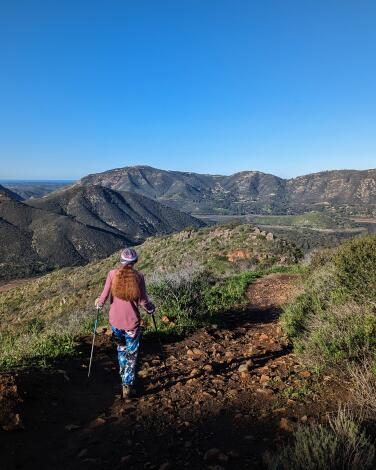
(Matt Pawlik)
When it’s complete, the Coast to Crest Trail (C2C) will be 71 miles, following the San Dieguito River and stretching from the river’s source at Volcan Mountain in Julian to Del Mar at the San Dieguito Lagoon. It is a truly incredible undertaking. For now, the completed portions of backbone system, managed by the San Dieguito River Park, make up for 49 miles of trails from the mountains across foothills and valleys to the coast. Each year, the San Dieguito River Valley Conservancy hosts a trail challenge that highlights five favorite hikes on or branching off the C2C Trail (such as the awesome Clevenger Canyon trails in the Pauma Valley). This year, one designated challenge trail travels along the pristine waters of Lake Hodges to the base of Bernardo Summit. Here’s how to enjoy it.
Start at the Sikes Adobe (open 10 a.m. to 1 p.m. Sundays), a historic farmstead with a museum featuring exhibits on the Kumeyaay and later Ranchos era, and walk down the road to the Coast to Crest Trail heading south. You’ll walk under the busy 15 Freeway and then flank the lake bed. Look for the David Kreitzer Lake Hodges Bicycle Pedestrian Bridge, named after a former planning commissioner and local environmentalist, which was designed specifically to have the least effect on the sensitive wildlife habitat. The 995-foot concrete walkway, also the world’s longest stress-ribbon bridge, offers great lake vistas and connects hikers to more of the park’s trail system, including the scenic Piedras Pintadas Trail. Continue west, passing over Felicita via a charming footbridge and then, at the 1.75-mile mark, turn right at the junction to begin your ascent. Atop the boulder-lined peak, there are plenty of rocks to perch on and relish the 360-degree views of NoCo, including perhaps the best vista of Lake Hodges. Sign the guestbook before beginning your descent and plan your next C2C hike.
Park along along Sunset Drive, near Sikes Adobe; dog-friendly. Head south on Sunset Drive to find the Coast to Crest Trailhead.
Start at the Sikes Adobe (open 10 a.m. to 1 p.m. Sundays), a historic farmstead with a museum featuring exhibits on the Kumeyaay and later Ranchos era, and walk down the road to the Coast to Crest Trail heading south. You’ll walk under the busy 15 Freeway and then flank the lake bed. Look for the David Kreitzer Lake Hodges Bicycle Pedestrian Bridge, named after a former planning commissioner and local environmentalist, which was designed specifically to have the least effect on the sensitive wildlife habitat. The 995-foot concrete walkway, also the world’s longest stress-ribbon bridge, offers great lake vistas and connects hikers to more of the park’s trail system, including the scenic Piedras Pintadas Trail. Continue west, passing over Felicita via a charming footbridge and then, at the 1.75-mile mark, turn right at the junction to begin your ascent. Atop the boulder-lined peak, there are plenty of rocks to perch on and relish the 360-degree views of NoCo, including perhaps the best vista of Lake Hodges. Sign the guestbook before beginning your descent and plan your next C2C hike.
Park along along Sunset Drive, near Sikes Adobe; dog-friendly. Head south on Sunset Drive to find the Coast to Crest Trailhead.
Show more Show less
Route Details
No matching entries.
Please reset filters to see all entries.
No matching entries.
Please reset filters to see all entries.
Top



